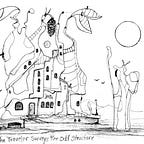Let The Stratification Begin
A New Micro-Prairie Begins
This photo shows native plant seed mixed with rice hull mulch spread on snow and bare ground on the east boulevard at my house. I spent all fall digging big, narly European bellflower roots out of the boulevard. If I don’t remove the roots, there will be an infestation of bellflower next year that will take over the boulevard (again). When I got around to spreading the seed, it had already snowed. Spreading native seeds on snow is common but this is the first time I have tried it. A few hours after I took the photo this spot was covered with snow that will last all winter. That should keep the seed from blowing away during blizzards while stratification (freeze/thaw cycles) activates the seed so it will germinate in the spring.
In this photo you can see the native grass clumps that I am trying to salvage. Most of the original native plants I put in did not survive so I am trying again with different seed mixes. I realized that the north three fourths of the boulevard are in shade all day when the trees leaf out. So I used a woodland seed mix on that part. The mix has many plants that do well in shade. A few of the plants in the mix can get tall so I will have to cut those back or move them out of the boulevard.
The south one fourth of the boulevard gets full sun all day. For this part I went with an echinacea mix that has short plants with colorful blooms. It should form an interesting contrast where the two areas meet. By providing a fairly large number of species I gave nature a chance to figure out what works in this space. My first attempt failed because I used a small selection of live plants which did not do well in the shade and near the black walnut tree in the center of the boulevard. That taught me that I shouldn’t try to “design” native plantings. The best solution is to throw down a wide selection of the seeds that grew here before the city was built and just get out of the way. Nature will design the planting for me.
Summer Delights
Summer in the micro-prairie is when all the weed digging and seeding pays off. Here is a collection of pictures from the summer of 2022 in the micro-prairie.
This view from the patio shows yellow (black-eyed susans), pale purple (beebalm) and white, pink and red (phlox) flowers in the heat of summer. In the background is an elm tree that came up on its own and is getting pretty big. A few years ago I cut down a tree in that spot and I wasn’t sure if there was enough room for another tree. It looks like there is enough room but I would rather have a fruit tree than an elm tree. The tree is growing next to the “pond” — a couple hog pans — and provides a nice oasis in the center of the garden. So, a plan for next spring may be to dig out the elm tree and replace it with a fruit tree and replace the pond with a larger pond. I would get a small piece of pond liner and make about a 4' x 5' pond with a sloping side so small creatures can get in and out of the water. I could do a step by step DIY article (with pictures) for the blog.
This photo is a little blurry because I was trying to get a picture of the monarch butterfly but it kept moving around. One day, three monarchs graced my yard. It is not like the flocks of monarchs that used to visit the yard but I will take it. There were also two or three yellow swallowtail butterflies that were regulars visitors plus bees and other pollinators. Providing habitat for insects and birds is a huge benefit of the micro-prairie.
The bush rose in this picture has been living here longer than I have (over 35 years). The rose along with some peonies and a rhubarb patch are the few non-native plants that remain in the yard. The rose seems to thrive along with the native plants.
In fall the New England asters bloom. The asters along with goldenrod and few others provide color when the summer flowers start to fade. Also, phlox, brown-eyed susans and black-eyed susans last well into fall.
I don’t know what this plant is. I remember seeing it grow in sloughs on the farm when I was kid. I searched the Prairie Moon website but couldn’t find a match. I assumed it was a plant in the PDQ mix that I used to create the micro-prairie but maybe it is something that was surviving in my yard all this time. If you know what it is, please let me know.
Next year should be interesting not only because of the new planting but because of the random way I scattered the left over seed mix. The two seed mixes I used for the new planting each covered 500 sq ft. The whole boulevard was about 500 sq ft so I had seed mix left over. I spread the woodland mix in bare areas on the north side of the house and the echinacea mix in the large area of phlox in the garden. At least some of the seed should find suitable spots to grow and add to the diversity of the micro-prairie.
So it is time to hunker down for winter but always keep doing what you can to create a diverse and healthy planet. Happy 2023.
